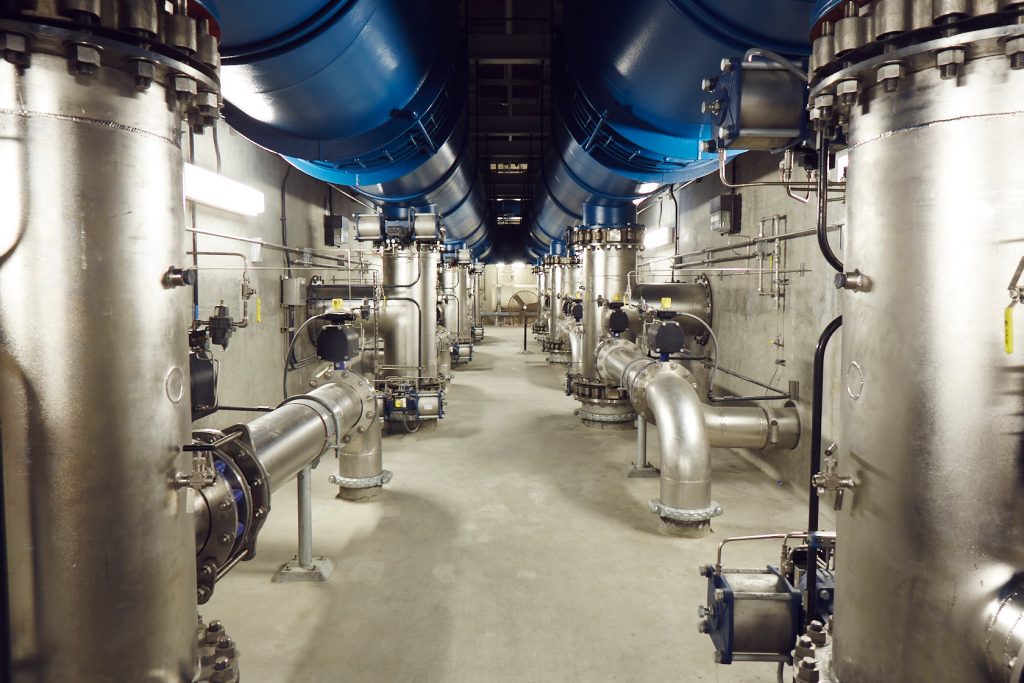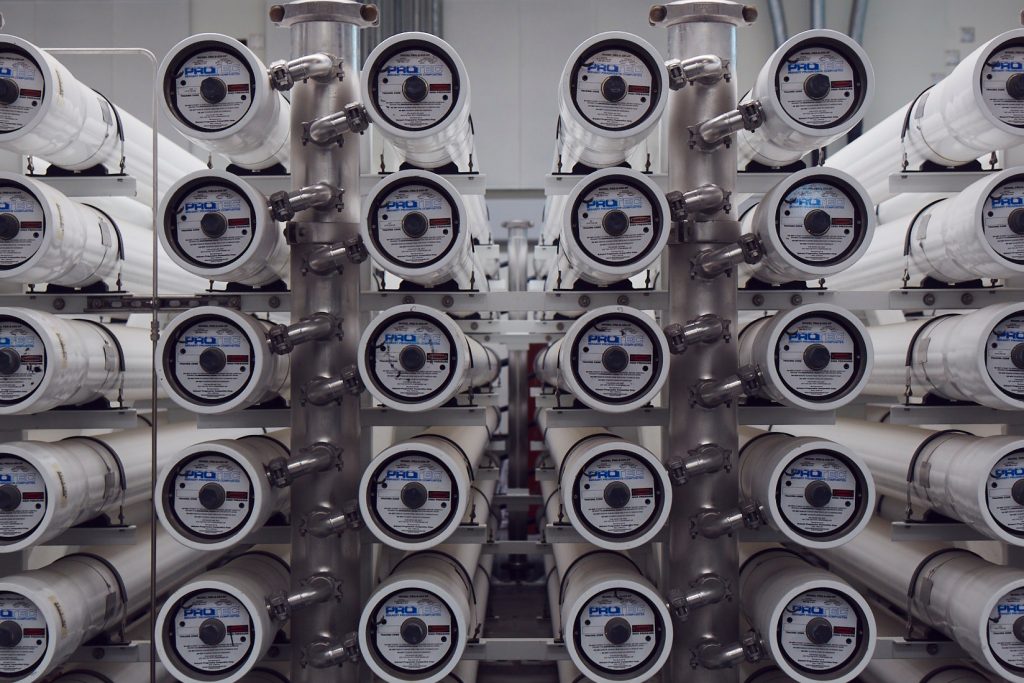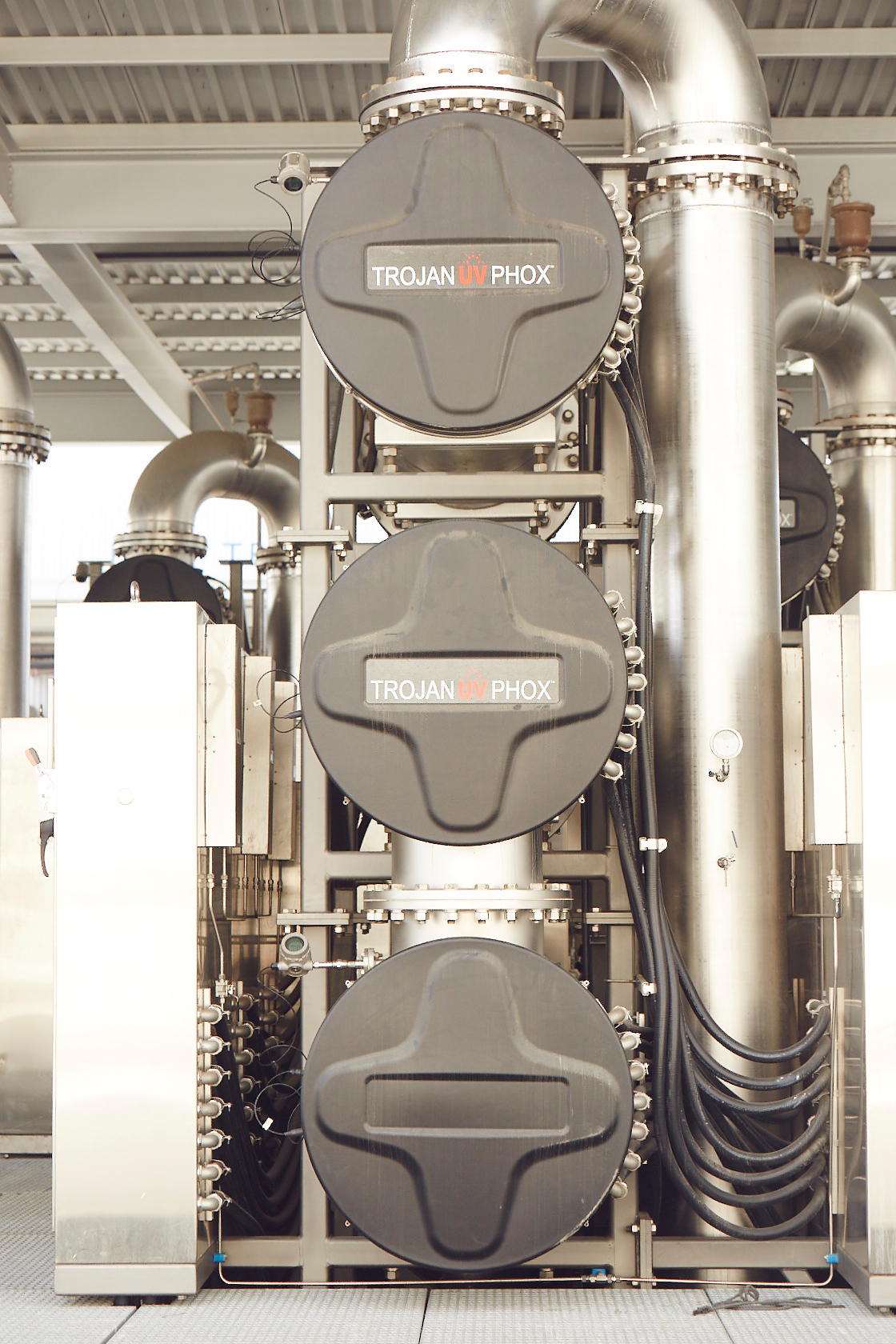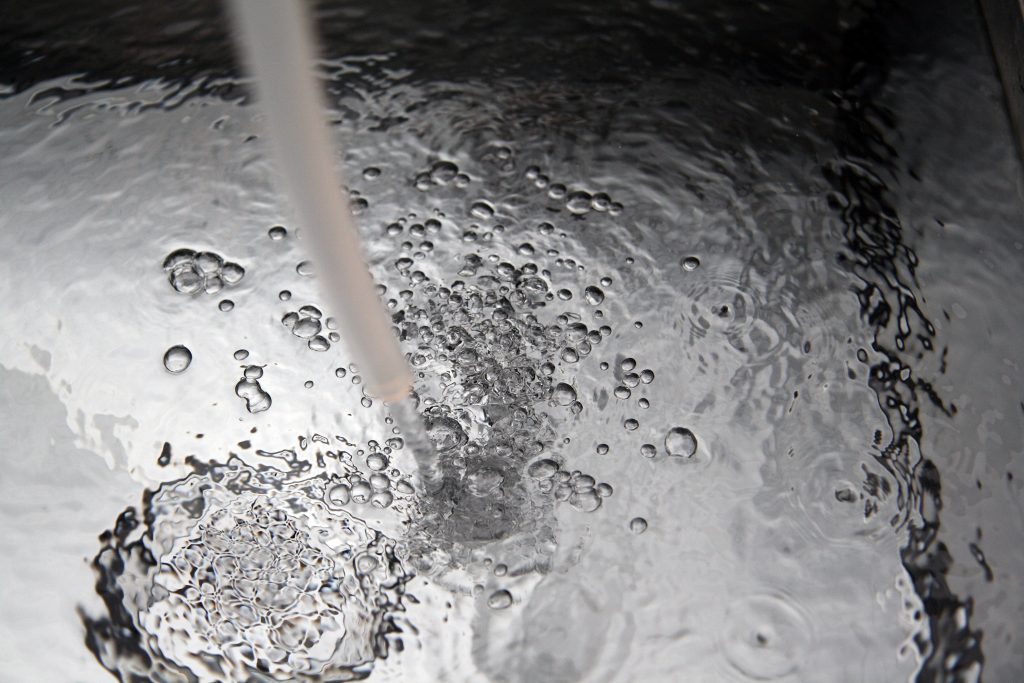Orange County Groundwater Replenishment
Location
Orange County, California is an urban area located on the coast of the Pacific Ocean, south of Los Angeles County. With a population of 3 million people as of 2010, it is California’s third most populous county.
The challenge
Orange County Water District (OCWD) is known for having built, in 1976, one of the first facilities in the US for turning wastewater into purified water. This initial project, called Water Factory 21, laid the foundation for a 2008 expansion into the world’s largest advanced water purification system for potable reuse. While the project was not initially conceived with ocean health in mind, it has saved billions of gallons of treated wastewater from being discharged into the ocean, while also providing clean water for hundreds of thousands of people in a drought-prone area.
By the mid-1970s, after experiencing a population boom and increased demand for water, Orange County’s underground fresh water aquifer had been drawn down. Saltwater from the ocean was seeping inland, posing a threat to the county’s drinking water supply. OCWD leaders decided to build a plant that could purify the county’s wastewater so that OCWD could inject the treated water back into the aquifer, where it acted as a barrier and staved off salt water intrusion.
The facility, known as Water Factory 21, was able to produce about 15 million gallons of clean water per day. As the county’s population grew, and more and more water was being withdrawn from underground aquifers, saltwater intrusion continued to be a problem. Drought was also common, resulting in frequent water shortages. At the time, the county’s water supply came from groundwater, the Santa Ana River, and was also imported at a significant cost from the Colorado River and from northern California. Importing more water was not as dependable during times of drought.
An additional problem facing the county was that a large outfall pipe, which sent treated wastewater from a treatment plant out into the ocean, had reached capacity. If water sources were expanded to match demand, the pipe would not be able to handle the additional volume.
OCWD leaders weighed different expansion plans, looking for the most affordable option that would also shore up the water supply even during droughts, eventually conceiving of the Groundwater Replenishment System project (GWRS). Under this plan, the OCWD partnered with the Orange County Sanitation District (OCSD) to build the world’s largest advanced water purification system for potable reuse.
Actions taken
The facility built by OCWD and OCSD became operational in 2008 and was initially able to produce 70 million gallons of clean water per day. In 2015, the plant was expanded to produce 100 million gallons per day, and the plant is currently undergoing another expansion which will produce 130 million gallons per day in 2023.
How it works
Before going to the purification plant, wastewater first undergoes a more typical treatment process called secondary treatment, which includes bar screens, grit chambers, trickling filters, activated sludge, clarifiers and disinfection. After this process is completed, it is sent to the GWRS plant. Designed by the engineering firm CDM Smith, the plant uses a three-step purification process.
1 – The first step is microfiltration, which relies on tiny polypropylene hollow fibers, similar to straws, with tiny holes in the sides that are 0.2 micron in diameter (1/300 the diameter of a human hair). By drawing water through the holes into the center of the fibers, suspended solids and pathogens are filtered out of the water.

Microfiltration involves the use of tiny polypropylene hollow fibers, similar to straws, with holes in the sides that are 0.2 micron in diameter (1/300 the diameter of a human hair). By drawing water through the holes into the center of the fibers, suspended solids and pathogens are filtered out of the water. Photo © Orange County Water District
2 – During the second step, the water undergoes reverse osmosis, where pressurized water is forced through a fine membrane that removes pathogens and chemicals, including pharmaceuticals.

After microfiltration, the water undergoes reverse osmosis, where pressurized water is forced through a fine membrane that removes pathogens and chemicals, including pharmaceuticals. Photo © Orange County Water District
3 – The third step involves a final treatment with ultraviolet light, which disinfects the water by denaturing the DNA of any remaining pathogens; hydrogen peroxide is also used to remove iron, tannins and low molecular weight organics through an advanced oxidation process, which breaks the molecular bonds of remaining contaminants. Minerals are added back into the water to buffer it and stabilize the pH, prior to entering the distribution system.

A final treatment with ultraviolet light disinfects the water by denaturing the DNA of any remaining pathogens; and hydrogen peroxide is also used to remove iron, tannins and low molecular weight organics through an advanced oxidation process, which breaks molecular bonds of remaining contaminants. Photo © Orange County Water District
GWRS treated water exceeds state and federal regulations for drinking water. (For more engineering details, see Groundwater Replenishment System Technical Tour.) The treated water, groundwater and surface waters are subject to extensive monitoring at the Philip L. Anthony Water Quality Laboratory, where it is tested for more than 500 compounds (the EPA only regulates 90, leaving thousands of chemicals unregulated). The lab tests water from approximately 1,500 locations throughout the basin, analyzes more than 20,000 samples each year and reports more than 400,000 results. OCWD also provides regional testing of more than 200 drinking water wells for local drinking water providers.
After treatment, about one-third of the volume produced is injected into deep wells along the coast, forming a freshwater barrier against seawater intrusion, and the remainder is used to help replenish the Orange County Groundwater Basin. This occurs by allowing the water to pool in large ponds and then percolate through sand and gravel via gravity for eventual storage in an underground aquifer. While the percolation process can provide additional filtration, in the case of OCWD the water has already been purified to near-distillation levels, and this step is largely for an additional layer of protection mandated by drinking water regulators in California. This also provides a psychological benefit, helping to allay consumer aversion to use of recycled water to augment traditional drinking water sources. Retailers withdraw the water from the basin through over 400 wells and pipe it to consumers.
How successful has it been?
The program currently supplies 100 million gallons per day, which is enough water to serve the needs of 850,000 people. The Orange County groundwater basin provides about 77% of the total water supply to 2.5 million people living in north and central Orange County. The plant is currently undergoing another expansion, which is expected to bring capacity up to 130 million gallons per day in 2023.
While this system was initiated primarily to secure clean water for residential and business use and was not initiated out of concern for the impact of treated wastewater discharge into the ocean, since its inception in 2008, the system has nonetheless created an estimated 329 billion gallons of recycled clean water. A significant portion of that water would likely have been discharged to the sea if the system had never been built and implemented.
The system does still create a waste stream. The purification process creates 85 percent clean water by volume, whereas 15 percent is sent back to OCSD to be further processed. At this point it looks like dark iced tea. Solids are separated and taken to a land fill. What is left is still discharged into the ocean through outfall pipes, which take the water five miles out into the ocean at a depth of two hundred feet below the surface of the water.
OCSD also harvests methane and hydrogen. The hydrogen is used for hydrogen cars, and there is a charging station at the front gate.
The GWRS has served as a model for other places, demonstrating that recycling water can work and become widely accepted as a wastewater treatment solution in a relatively affluent major metropolitan area. The district has collaborated with Singapore, which constructed and now uses at least three smaller plants using similar technology, and numerous cities across California, the US and the world are now considering whether wastewater reclamation could work for them.

Minerals are added back into the purified water to buffer it and stabilize the pH, prior to entering the distribution system. Photo © Orange County Water District
Lessons learned
- Public outreach can never stop, and it has to be early and often. Orange County learned from early failures in San Diego in 1994, and Los Angeles in 2000, where both tried to pass water recycling programs and failed. In LA, social justice perceptions played a role, as it was poorer areas that were slated to receive the recycled water. San Diego has since built a (more expensive, energy-intensive) ocean desalinization plant.
- OCWD has invested in working with schools to engage kids, including an annual water festival for 5th and 6th graders and classes geared at young adults, taught through local community colleges; the District offers free tours of the plant to the public; the website is sophisticated, with simplified explanations and videos, as well as libraries of more in-depth reports.
- The GWRS has been extremely well-received. Of 158 articles about the operation published in periodicals between 2000-2016, there was zero negative coverage, with the majority of articles deemed either neutral (72%) or positive (28%).
- Teaching the staff who run the plant how to speak publicly about their work without jargon, and having them do the outreach and presentations, rather than PR firms, has been effective. California recently passed a law that allows the facility to bottle a small portion of the water produced there, which means staff can bring the water to festivals and community fairs so people can see that the water is sparkling clean. The fear of drinking recycled water decreases with familiarity.
- Having an aquifer where the water can be reinjected provides a psychological advantage for allaying public aversion. It also provides an additional layer of protection insuring the recycled water mixes with native groundwater.
- Improvements in membrane technology have reduced the energy cost of reverse osmosis by 75% since the 1970s.
- People often ask why the county doesn’t desalinate ocean water. It’s more challenging and more expensive to purify salt water than to purify sewage. Ocean water has about 35,000 ppm of salts, whereas sewage has less than 2000 ppm.
- It is a large financial undertaking, with costs close to $1 billion, and estimates for doing the same program today are closer to $2 billion.
- Over time, regulations have been refined as data has come in from facilities like the GWRS. When the program first started, the California Division of Drinking Water required the water to be stored underground for six months, which created some infrastructure and engineering challenges. Now, the underground storage time has been reduced to three months.
Funding summary
The total estimated cost of GWRS construction is nearly $1 billion ($973 million, with $481 million in construction costs for the initial 70 million gallons per day facility). This was paid for by $135 million in low-interest federal loans and $167 million in low-interest state loans, with grants making up the difference, including $90 million dollars in subsidies from agencies, including the California Department of Water Resources, the Environmental Protection Agency, Metropolitan Water District of Southern California, and others.
Importing water from elsewhere costs approximately $1,000 per acre-foot; whereas the cost of water produced at GWRS is $525 per acre-foot with subsidies, or $850 per acre-foot without subsidies.
Lead organizations
Orange County Sanitation District & Orange County Water District
Partners
CDM Smith (engineering)
Black and Veatch (engineering)


